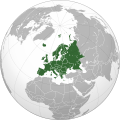Wikipedia:WikiProject Germany/Portal:Baden-Württemberg
Introduction

Baden-Württemberg (/ˌbɑːdən ˈvɜːrtəmbɜːrɡ/ BAH-dən VURT-əm-burg; German: [ˌbaːdn̩ ˈvʏʁtəmbɛʁk] ⓘ), commonly shortened to BW or BaWü, is a German state (Land) in Southwest Germany, east of the Rhine, which forms the southern part of Germany's western border with France. With more than 11.07 million inhabitants as of 2019[update] across a total area of nearly 35,752 km2 (13,804 sq mi), it is the third-largest German state by both area (behind Bavaria and Lower Saxony) and population (behind North Rhine-Westphalia and Bavaria). The largest city in Baden-Württemberg is the state capital of Stuttgart, followed by Mannheim and Karlsruhe. Other major cities are Freiburg im Breisgau, Heidelberg, Heilbronn, Konstanz, Pforzheim, Reutlingen, Tübingen, and Ulm.
Modern Baden-Württemberg includes the historical territories of Baden, Prussian Hohenzollern, and Württemberg. Baden-Württemberg became a state of West Germany in April 1952 through the merger of South Baden, Württemberg-Baden, and Württemberg-Hohenzollern. These states had been created by the Allies as they separated traditional states into occupation zones after World War II.
Baden-Württemberg is especially known for its strong economy with various industries like car manufacturing, electrical engineering, mechanical engineering, the service sector, and more. It has the third-highest gross regional product (GRP) in Germany. Part of the Four Motors for Europe and located in the Blue Banana, some of the largest German companies are headquartered in Baden-Württemberg, including Mercedes-Benz Group, Schwarz Group, Porsche, Bosch and SAP.
The sobriquet Ländle, a diminutive of the word Land in the local Swabian, Alemannic and Franconian dialects, is sometimes used as a synonym for Baden-Württemberg. (Full article...)
Selected article

The Venus of Hohle Fels (also known as the Venus of Schelklingen; in German variously Venus vom Hohlen Fels, vom Hohle Fels; Venus von Schelklingen) is an Upper Paleolithic figurine of a woman hewn from the ivory of a mammoth tusk that was located near Schelklingen, Germany. It is dated to between 35,000 and 40,000 years ago, belonging to the early Aurignacian, at the very beginning of the Upper Paleolithic, which is associated with the earliest presence of Cro-Magnon in Europe. This female figure is the oldest undisputed example of a depiction of a human being yet discovered. In terms of figurative art only the lion-headed, zoomorphic Löwenmensch figurine is older. The Venus figurine is housed at the Museum in Blaubeuren (Urgeschichtliches Museum Blaubeuren).
The Swabian Alb region of Germany has a number of caves that have yielded many mammoth-ivory artifacts of the Upper Paleolithic period. Approximately twenty-five items have been discovered to date. These include the Löwenmensch figurine of Hohlenstein-Stadel dated to 40,000 years ago and an ivory flute found at Geißenklösterle, dated to 42,000 years ago. This mountainous region is located in Baden-Württemberg and is bounded by the Danube in the southeast, the upper Neckar in the northwest, and in the southwest it rises to the higher mountains of the Black Forest.
Selected biography

Roland Emmerich (German: [ˈʁoːlant ˈɛməʁɪç]; born November 10, 1955) is a German film director, screenwriter, and producer. His films, most of which are English-language Hollywood productions, have made more than $3 billion worldwide, including just over $1 billion in the United States, making him the country's 14th-highest grossing director of all time. He began his work in the film industry by directing the film The Noah's Ark Principle (1984) as part of his university thesis and also co-founded Centropolis Entertainment in 1985 with his sister. He is a collector of art and an active campaigner for the LGBT community, and is openly gay. He is also a campaigner for awareness of global warming and equal rights. Emmerich was born in Stuttgart, West Germany, and grew up in the nearby town of Sindelfingen. In 1977, he began attending University of Television and Film Munich with the intention of studying to become a production designer.
State facts
- Nickname: Ländle
- Capital: Stuttgart
- Minister-president: Winfried Kretschmann
- Governing parties: Greens / CDU
- Total area: 35,751 km2 (13,804 sq mi)
- Population: 10,879,618 (2015)
- Founded: April 25, 1952
- Website: www.baden-wuerttemberg.de
Selected image
Did you know?

- ...that the 18th-century Schloss Bruchsal is noted for its fine Roccoco decoration and in particular its grand Baroque entrance staircase, which is regarded as one of the finest examples of its genre.
- ... that the Schwarzwaldverein (Black Forest Association) was founded in Freiburg im Breisgau in 1864, making it the oldest German hiking and mountaineering club. The Schwarzwaldverein has almost 90,000 members in 241 local chapters.
Subcategories
Selected panorama
 |
Maulbronn Monastery (German: Kloster Maulbronn) is a former Roman Catholic Cistercian Abbey and Protestant seminary located at Maulbronn in the German state of Baden-Württemberg. The 850 year old, mostly Romanesque monastery complex, one of the best preserved examples of its kind in Europe, is one of the very first buildings in Germany to use the Gothic style. In 1993, the abbey was declared a UNESCO World Heritage Site.
Topics
Related portals
Associated Wikimedia
The following Wikimedia Foundation sister projects provide more on this subject:
-
Commons
Free media repository -
Wikibooks
Free textbooks and manuals -
Wikidata
Free knowledge base -
Wikinews
Free-content news -
Wikiquote
Collection of quotations -
Wikisource
Free-content library -
Wikiversity
Free learning tools -
Wikivoyage
Free travel guide -
Wiktionary
Dictionary and thesaurus
















